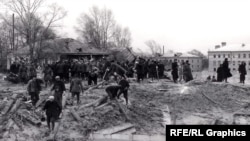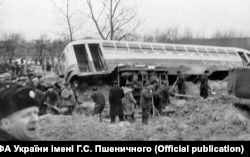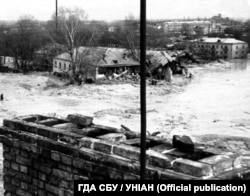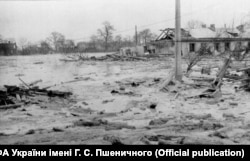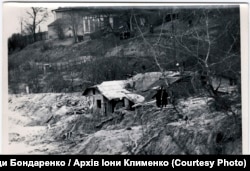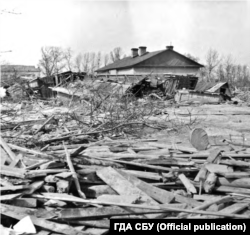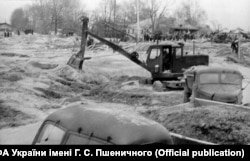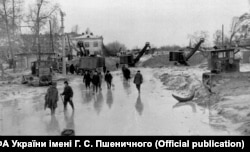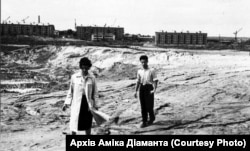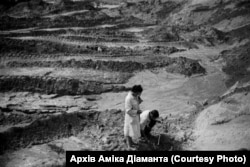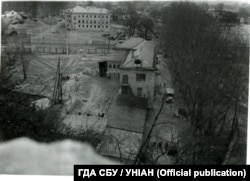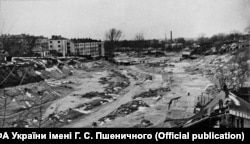
Babyn Yar was the site of one of the worst Nazi massacres. About 34,000 Jews were killed in the ravine in the Ukrainian capital, Kyiv, on September 29-30, 1941, soon after the Nazis occupied the city. Over the succeeding months, they killed about 100,000 people at the site, including Soviet prisoners of war, communists, Ukrainian nationalists, and Roma.
Today, Babyn Yar is one of the terrible symbols of the Holocaust. But after World War II, Soviet authorities preferred to bury the site under a landfill.
Later, the massacre site was filled with liquid waste from nearby brick factories. The plan was to drain the waste and have the remaining mud and pulp fill the ravine.
But on the evening of March 12, 1961, amid heavy rain, the pumping station at the dam failed. And at 8:30 a.m. the next day, the 4 million cubic meters of slurry that had been dumped into Babyn Yar for over 10 years broke through the site’s small earthen dam and inundated the city’s low-lying Kurenivka district.
The embankment — 4 meters high and 20 meters wide — collapsed, and the liquid mud it had been holding back all those years was unleashed, destroying everything in its path.
Olha Bikus, an eyewitness, said that she saw whole houses and trees carried away by the tsunami of slurry, which didn’t stop until 10 a.m.
The wall of mud completely destroyed 68 residential and 13 office buildings. In just a few minutes, almost 1,300 people found themselves homeless.
One of the worst-hit sites was the Krasin tram depot (above and below), where 50 workers were buried alive.
People caught in the flooding had little chance of survival, unless they were lucky enough to climb trees or onto roofs.
The military was called in to help with rescue efforts and to clean up the mud and debris. Excavators repeatedly unearthed the body parts of victims.
“It was scary! Some excavator drivers could not even work and left their jobs,” one eyewitness said.
Public transport in the Kurenivka district was also caught by the mudslide. In one tram, 12 passengers were buried alive. Elsewhere, a bus caught fire after it was hit by a falling electrical pole and most of the people inside were killed.
No News Allowed
Soviet authorities strictly censored any mention of the catastrophe.
After the dam broke, Soviet troops immediately surrounded the perimeter of the flooding and did not let anyone in. Long-distance communication in Kyiv was cut off.
People in Kyiv were outraged that news of the catastrophe was being suppressed.
Some called the flood the “revenge of those shot” in Babyn Yar, while others called it “God’s punishment” for the closure of Kyiv’s Pechersk Lavra monastery.
The KGB confiscated photos and film of the incident. News of the tragedy wasn’t even aired on the radio in Kyiv until three days later, and it was never announced outside the city.
Victims of the mudslide were buried in cemeteries around Kyiv with different dates of death and the official causes of death changed.
In 1962, the Babyn Yar ravine was leveled off and made into a park.
An official memorial to Soviet citizens shot at Babyn Yar was erected in 1976, but it wasn’t until after the collapse of the Soviet Union that a memorial was built to the Jewish victims.
How Many People Actually Died?
According to official Soviet figures, 145 people were killed in the disaster. But after news of the tragedy was suppressed, people in Kyiv did not trust official statements.
According to one modern Kyiv historian, Oleksandr Anisimov, the Kurenivka mudslide of 1961 took the lives of up to 1,500 people.
But another historian, Tetyana Yestafyeva , who was one of the first to work with archival documents on the tragedy, believes that number is exaggerated.
“I believe the official data I found in the documents classified as ‘top secret.’ They were sent to the highest offices of Kyiv and Moscow. It doesn’t make any sense for party leaders to lie to themselves,” Yestafyeva says. “Therefore, I believe that 145 people were victims of the Kurenivka tragedy and that many more were injured.”
Six months after the tragedy, the Kyiv regional court sentenced six people for their roles in the dam collapse: two engineers from Moscow and four heads of the Kyiv construction department.
The case materials were subsequently destroyed.
